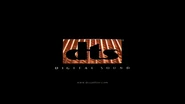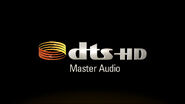
The DTS logo
DTS (formerly known as Digital Theater Systems), owned by DTS Inc., is a multi-channel surround sound format used for both commercial/theatrical and consumer grade applications (with significant technical differences between home and commercial/theatrical variants: the latter being a traditional ADPCM compression system and the former a sophisticated hybrid perceptual and signal-redundancy compressor).
It is used for in-movie sound both on film and on DVD, and during the last few years of the format's existence, several Laserdisc releases had DTS soundtracks. The company which created it, Digital Theater Systems, is now referred to simply as DTS.
One of the company's initial investors was film director Steven Spielberg, who felt that theatrical sound formats up until the company's founding were no longer state of the art, and as a result were no longer optimal for use on projects where quality sound reproduction was of the utmost importance.
Work on the format started in 1991, four years after Dolby Labs started work on their new codec, Dolby Digital. The basic and most common version of the format is a 5.1 channel system, supporting five primary speakers and a subwoofer, referred to as an LFE (Low Frequency Effects) channel. Note however that encoders and decoders support numerous channel combinations and stereo, four-channel and four-channel+LFE soundtracks have been released commercially on DVD, CD and LaserDisc.
Other newer DTS variants are also currently available, including versions that support up to 7 primary audio channels (DTS-ES). DTS's main competitors in multichannel theatrical audio are Dolby Digital and SDDS, although only Dolby Digital and DTS are used on DVDs and implemented in home theater hardware. Spielberg debuted the format with his 1993 production of Jurassic Park, which came slightly less than a full year after the 'official' theatrical debut of Dolby Digital (Batman Returns). In addition, Jurassic Park also became the first home video release to contain DTS sound when it was released on Laserdisc in January 1997, two years after the first Dolby Digital home video release (Clear and Present Danger on LaserDisc) which debuted in January 1995.
In theatrical use, information in the form of a modified time code is optically imaged onto the film, a DTS processor in the projection booth uses this timecode to synchronize the projected image with the soundtrack audio, which is recorded in compressed form on standard CD-ROM media at 1.5 Mbit/s. The processor also acts as a transport mechanism, it holds and reads the audio discs. The units can generally hold 3 discs, allowing a single processor/transport to handle 2-disc film soundtracks along with a 3rd disc containing sound for theatrical trailers. In addition, specific elements of the imprinted timecode allow identifying data to be embedded within the code, ensuring that a certain film's soundtrack will only run with that film.
One advantage of DTS (for DVDs) is that it has a much higher bitrate than equivalent Dolby tracks. DTS 5.1 typically uses 768-1536 kbit/s (overall), while Dolby 5.1 uses 384-448 kbit/s. Proponents claim these extra bits give higher fidelity and a greater dynamic range, providing richer and more lifelike sound. They also claim that DTS is louder and has less hiss at the same volume.
DTS as a codec[]
DTS is an enhanced copy (and, according to some movie industry insiders, a hacking) of a French patent called LC Concept, first used in 1990 for the movie Cyrano de Bergerac.
On the consumer level, DTS is the oft-used shorthand for the DTS Coherent Acoustics codec, transportable through S/PDIF and used on DVDs, CDDAs and in WAV files. This system is the consumer version of the DTS standard, using a similar codec without needing separate DTS CD-ROM media.
DTS playback[]
Since DTS is not a mandatory codec for current generation DVD devices, many players do not support it. Users wishing to playback special DTS soundtracks require some piece of equipment or software which is capable of decoding DTS. For home cinema equipment, most users choose either a DVD player which can decode DTS soundtracks or a separate amplifier which supports DTS decoding. Most modern HT receivers support DTS.
For PC playback, many software players support the decoding of DTS. The VideoLAN project has created a decoding module for DTS called libdca (formerly libdts) which is the first open source implementation of DTS.
DTS variants[]
In addition to the standard 5.1 channel DTS Surround codec, the company has several other technologies in its product range designed to compete with similar systems from Dolby Labs. The primary new technologies are:
- DTS-ES - Contains extra information for a rear-center channel speaker (or two rear-center speakers playing in mono with 7.1 home theater systems) that can be utilized with the proper equipment. The codec can work in one of two ways, depending on how the sound was originally mastered and stored. Most commonly, DTS-ES works on a Matrix system, whereby processors that are compatible with the ES codec look for and recognize "flags" built into the audio coding and "un-fold" the rear-center sound from data that would otherwise be sent to rear surround speakers. This is notated as DTS-ES 5.1. Less frequently, DTS-ES data can be encoded with a Discrete 6th audio channel (the rear-center), meaning that the audio data for the 6th channel is stored separately from the other information, and is not embedded or matrixed among other channels. This is notated as DTS-ES 6.1, as the center rear is completely discrete from the other channels. ES capable processors can recognize the discrete 6th channel, and play it back if connected to the necessary speaker(s). In contrast, Dolby's competing EX codec, which also boasts a center rear channel, can only handle matrixed data and does not support a discrete 6th channel. DTS-ES is backward compatible with standard DTS setups, so non-ES equipment which does not recognize the flags or with ES enabled equipment that lack the extra speaker connections, sound plays back in 5.1 as if it were standard DTS.
- DTS NEO:6 - Neo:6, like Dolby's Pro-Logic IIx system, can take stereo content and convert the sound into 5.1 or 6.1 channel format.
- DTS 96/24 - Allows the delivery of 5.1 channels of 24-bit, 96 kHz audio and high quality video on the DVD-Video format. Prior to the invention of DTS 96/24, it was only possible to deliver two channels of 24-bit, 96 kHz audio on DVD-Video. DTS 96/24 can also be placed in the video zone on DVD-Audio discs, making these discs playable on all existing DVD players.
- DTS-HD Master Audio - Previously known as DTS++ and DTS-HD, DTS-HD Master Audio supports a virtually unlimited number of surround sound channels, can downmix to 5.1- and two-channel, and can deliver audio quality at bit rates extending from DTS Digital Surround up to lossless. Although technically superior over its Dolby counterpart, DTS-HD Master Audio is selected only as an optional surround sound format for Blu-ray and HD-DVD. DTS-HD Master Audio and Dolby TrueHD are the only technologies that deliver lossless surround sound for these new disc formats, ensuring the highest quality audio performance available in the new standards. (n.b. DTS Coherent Acoustics coding system has been selected as mandatory audio technology for both the Blu-ray Disc (BD) and High Definition Digital Versatile Disc (HD-DVD) - [1])
Gallery[]
Releases[]
| Release date | Title | Distributor | Format | Trailer |
|---|---|---|---|---|
| March 19, 1997 | The Long Kiss Goodnight | Image Entertainment New Line Home Video |
Laserdisc | |
| April 16, 1997 | 12 Monkeys | MCA/Universal Home Video | ||
| April 23, 1997 | Casino | |||
| May 7, 1997 | Mortal Kombat | Image Entertainment New Line Home Video |
||
| September 10, 1997 | Daylight | MCA/Universal Home Video | ||
| January 28, 1998 | The Frighteners | |||
| March 25, 1998 | Dante's Peak Signature Collection |
|||
| May 27, 1998 | Austin Powers: International Man of Mystery | Image Entertainment New Line Home Video |
||
| July 29, 1998 | Dark City | |||
| August 5, 1998 | Wag the Dog | |||
| January 12, 1999 | Daylight | Universal Studios Home Video | DVD | |
| March 16, 1999 | 12 Monkeys | |||
| March 30, 1999 | Blade | Image Entertainment New Line Home Video |
Laserdisc | |
| April 20, 1999 | Rush Hour | |||
| July 6, 1999 | Amistad | DreamWorks Home Entertainment | DVD | |
| Antz | ||||
| MouseHunt | ||||
| Small Soldiers | ||||
| October 24, 2000 | American Beauty | DreamWorks Home Entertainment | ||
| February 9, 2016 | Love the Coopers | Lionsgate Home Entertainment CBS Home Entertainment |
Blu-ray | |
| January 3, 2017 | Middle School: The Worst Years of My Life | Lionsgate Home Entertainment CBS Home Entertainment |
Blu-ray | |
| July 18, 2017 | Free Fire | Lionsgate Home Entertainment | Blu-ray | |
| January 30, 2018 | Last Flag Flying | Lionsgate Home Entertainment | Blu-ray | |
| July 31, 2018 | Dark Crimes | Lionsgate Home Entertainment | Blu-ray | |
| May 21, 2019 | Trading Paint | Lionsgate Home Entertainment | Blu-ray | |
| June 11, 2019 | Five Feet Apart | Lionsgate Home Entertainment CBS Home Entertainment |
Blu-ray | |
| August 27, 2019 | The Last Black Man in San Francisco | Lionsgate Home Entertainment | Blu-ray | |
| October 8, 2019 | Midsommar | Lionsgate Home Entertainment | Blu-ray | |
| December 3, 2019 | Semper Fi | Lionsgate Home Entertainment | Blu-ray | |
| March 10, 2020 | Uncut Gems | Lionsgate Home Entertainment | Blu-ray |
See also[]
- LC Concept
- Home cinema
- Codec
- AC3
- Coherent Acoustics
- Dolby vs DTS
External links[]
| This page uses content from the English Wikipedia. The original article was at DTS. The list of authors can be seen in the page history. As with MOVIEPEDIA, the text of Wikipedia is available under the Creative Commons Attribution-ShareAlike 3.0 Unported License. |























